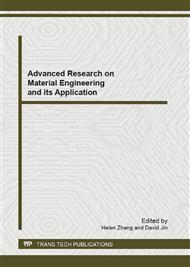[1]
Junxiang Fei. Slurry and granular material transport hydraulics, Beijing: Tsinghua University Press(1994).
Google Scholar
[2]
Wasp E, J, etc. Slurry pipeline transportation of solid materials, translation of the Yellow River Conservancy Commission, Beijing: Water Conservancy and Electric Power Press(1980).
Google Scholar
[3]
Defang Shu, Xihuan Sun, Yongye Li, etc. Research Situation of Slurry Pipeline Pressure Loss[J]. Technology and Application, 1: 38-40, (2011).
Google Scholar
[4]
Xiangji Deng, Fusheng Ni, Rongmin Luo. Two kinds of calculation model of resistance losses in pipeline transport sand [J]. Hehai University Changzhou Campus Journal, 19(1): 54-59, (2005).
Google Scholar
[5]
Guangwen Chen, Desheng Gu. Resistance Loss Calculation of Slurry Horizontal Pipeline[J]. Guizhou University Journal (Natural Science Edition), 25 (2): 162-166, (1994).
Google Scholar
[6]
Guangwen Chen. Slurry Pipeline flow characteristics and resistance characteristics analysis [J]. Non-ferrous Metals Journal, 46 (1): 15-19, (1994).
Google Scholar
[7]
Lijuan Zhao, Fusheng Ni. Wasp method of Fine sediment pipeline pressure loss calculation[J]. Hehai University Changzhou Campus Journal, 20 (3) : 62-64, (2006).
Google Scholar
[8]
J.A.K. Suykens Vandewalle J. Chaos control using least-squares support vector machines[J]. International Journal of circuit theory and applications, 27: 605-615, (1999).
DOI: 10.1002/(sici)1097-007x(199911/12)27:6<605::aid-cta86>3.0.co;2-z
Google Scholar
[9]
J.A.K. Suykens, J. De Brabanter, L. Lukas, et al. Weighted least squares support vector machines: robustness and sparse approximation[J]. Neurocomputing , 48 : 85–105, (2002).
DOI: 10.1016/s0925-2312(01)00644-0
Google Scholar
[10]
Yan Weiwu, Zhu Hongdong, Shao Huihe. Soft Sensor Modeling Based on Support Vector Machines[J]. Journal of System Simulation (China), 15(10): 1494-1496, (2003).
Google Scholar
[11]
Liu Han, Liu Ding, Zheng Gang, Liang Yanming, Song Nianlong. Natural Gas Load Forecasting Based on Least Squares Support Vector Machine[J]. Journal of Chmical Industry and Engineering (China), 55(5): 828-832, (2004).
DOI: 10.1109/icmlc.2004.1378571
Google Scholar


